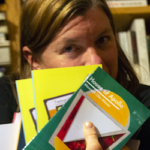PUBLISHED NOVEMBER/DECEMBER 2021
by
Deb Vanasse, Reporter,
IBPA Independent magazine --

Deb Vanasse
Authors and independent publishers are successfully using serialization and subscription apps like Wattpad, Radish, Substack, and Kindle Vella to expand reader engagement and enhance their bottom line.
Charles Dickens did it. So did Jack London. So did a host of well-published novelists in the 19th and early 20th centuries.
With today’s innovative digital storytelling platforms, what’s old has become new again. If Dickens and London were alive now, there’s a good chance they’d be jumping on platforms like
Wattpad,
Radish,
Substack, and
Kindle Vella to serialize their work as they once did in magazines.
Scrolling story episodes on a mobile device may be a new reader experience, but authors and independent publishers are successfully using these serialization and subscription apps to achieve the evergreen goals of expanding reader engagement while enhancing their bottom line.
Wattpad

Crystal McCoy
Launched in 2006 and attracting an audience mostly of Generation Z and millennial readers, Wattpad is among the original digital storytelling platforms aimed at authors who publish independently. Writers posting on Wattpad aren’t paid, but the platform helps them find and communicate with an audience. “Writers on Wattpad interact directly with a community of readers who provide feedback in real time,” says Crystal McCoy, the company’s publicity manager. “It’s similar to browsing the shelves of a bookstore or library filled with stories. But posting on Wattpad is much easier than, say, shopping around to agents in hopes that someone will read and enjoy your work.”
For independent publisher Michael Hynes, connecting with an audience is a big advantage of the platform. He started posting on Wattpad in 2017 as a way of testing the waters for his science fiction and fantasy work, published under the pen name Boris L. Slocum.

Michael Hynes
“I got some good reviews there for my writing,” Hynes says. “Readers there often are of the interactive variety, giving detailed comments on how they think the story should be written and where it should go next. I have no problem with that. I write the story that I think needs writing, but I am always willing to listen to the views of others. If folks enjoy one of my curious tales, that makes me happy. Even one good consumer review brightens my day.”
Hynes was eventually invited to join the Wattpad Stars program, which he says was “a true honor.” Stars are positioned for, though not guaranteed, monetization opportunities on the platform.
“Writers can be selected to participate in
Wattpad Paid Stories, where they can make money directly on Wattpad,” McCoy says. “They can work with our brand partners on sponsored stories, and using the platform can lead to getting publishing, TV, or film deals with Webtoon Studios.” Wattpad is best known for romance, McCoy says, but the platform features “a wide range of diverse voices,” including niche markets like LGBTQIA+ and people of color-led fantasy and science fiction. Overall, she says Wattpad has helped democratize publishing. “There was a time when certain works, such as comic books or romance novels, weren’t viewed as quite legitimate due to their consumer appeal,” she says. “We know that it’s quite the opposite. All stories are real and worth sharing.” McCoy says Wattpad has also made the industry more accessible. “The platform has allowed voices from all over the world who may have never [before] considered becoming authors to publish works that 90 million readers can get their eyes on,” she says.
Radish
In 2015, the Radish platform launched with the goal of helping independent publishers break into the digital storytelling space. Radish chooses its author/publishers through an application process, and the company also solicits work from authors they feel will be a good fit.

Alana Albertson
Independent publisher Alana Albertson began publishing in serial format before she discovered Radish. “I was obsessed with the TV show
Homeland and wanted to write something serial,” she says. “I started writing my serial
Se7en Deadly SEALs in 2014. I released it on all platforms. In 2017, I met the CEO of Radish at the Romance Writers of America conference where I was speaking about being a six-figure indie author. He begged me to release my serial on Radish.”
She gave it a try and found success, tallying some five-figure months when she was releasing new material daily. Overall, she has now earned six figures from the serial, which she’s turning into multiple revenue streams through translations.
“Writing a true serial opens up a world of opportunities,” she says. “For me, not only did I make a bunch of money, but it also led me to TV writing. I was accepted into a master class at Hedgebrook with Meredith Stiehm, the showrunner of Homeland, and I have since had my upcoming traditionally published book, Ramón and Julieta, optioned for TV. Because of my experience writing serials, I will be able to be in the writer’s room for my TV show.”
After teaching other author/publishers about serializing on Instagram and through newsletters, Albertson now offers an online class on the topic. She says that while publishers can successfully serialize backlist titles, they’ll find more success if they write with a serial in mind.
“Many authors take their old novels and just split up chapters,” she says. “You can make additional money on your backlist that way, but you won’t see the income that you would have if it had been a true serial. I think the key is creating a great cast of characters, using cliffhangers, and having multiple season and series arcs. I think of a serial as a TV show with different seasons and each chapter as a scene. I still put my backlist and frontlist (pre-release) up on Radish, but I don’t consider them serials.”

Though Albertson writes romance, one of Radish’s target genres, she believes any genre can be serialized. Successful as she’s been on Radish, she says the audience doesn’t necessarily cross over to read on other platforms. She also notes recent changes to Radish’s payment structure and the platform’s promotion of ghostwritten serials created in their writers’ rooms.
Like Albertson, author Anna Lowe of Twin Moon Press tried Radish after a company representative reached out to her. She agreed to publish a five-book romance series during a three-month window. After earning “a low four figures” for the series, she left the platform after fulfilling her obligation. She earns more publishing on other platforms, she says, and Radish’s younger audience produced “no new loyal readers who followed me across platforms.”
A big drawback for Lowe was that some readers felt cheated when, after reading a few episodes for free, they had to pay to read the rest. “I much prefer to sell a book upfront for a clear price rather than trick readers into paying more and more for each successive chapter,” she says. She also had some trouble getting paid in the time frame she’d negotiated, which was shorter than the usual six-month schedule. All in all, it’s not a publishing experience she’s looking to repeat.
Substack
Substack was founded in 2020 by a team of journalists who thought there had to be a better way to engage with readers than the usual social media platforms. For authors, the platform bills itself as the best way to grow a following through a subscription service. It integrates social sharing with software designed to accommodate both story and e-newsletter formats.
Substack quickly diversified beyond its journalistic roots. Novelist Salman Rushdie, for instance, is serializing a novella and chatting with readers about literary topics on Substack. In another arrangement reported by
Publishers Weekly (August 19, 2021), author Anand Giridharadas has used the platform to serialize the first two chapters of his book
The True American. His publisher, Norton Trade, agrees that tapping the author’s existing Substack audience is a great way to generate interest in the 2014 title, which has new relevance in today’s sociopolitical climate.

Miette Gillette
Publisher Miette Gillette of Whiskey Tit says the company has developed a serial audience through Substack with author Joey Truman. “Joey’s readers become ensconced in the details of his life that he shares on Substack, and it’s allowed us to expand our reach of his traditional print titles,” Gillette says. “The flexibility of the platform also allows him to include free. subscribers on posts at his choosing, abiding even greater experimentation.”
Since Whiskey Tit is an experimental press, Gillette views the use of innovative storytelling platforms as an extension of the company’s ethos. “The material that goes out via our Substack is often unedited, raw, and sent in a hot-off-the-press fashion,” she says.
Gillette attests to the platform’s ease of use, noting that Truman is not especially tech-savvy. By attending to metadata, Whiskey Tit has gained referral subscribers. “Because we have mailing addresses of all these direct-to-reader subscribers, I’ve successfully marketed other projects to them in direct-mail campaigns,” she says. At the same time, she says the openness of Substack’s reader stats can be a disadvantage. “As Truman’s publisher, I’d sometimes like to shelter him from knowing which readers read which emails,” she says.
Overall, Gillette says the project they’ve done with Truman on Substack has allowed them to “find our most ardent audience.” At the same time, she notes that Substack has some drawbacks that she associates with blogging platforms. “People will not want to pay immediately, and it still takes marketing and patience to build a readership,” she says.
Kindle Vella
Launched in July 2021, Kindle Vella is Amazon’s new digital storytelling platform. Featuring episodes 600 to 5,000 words long, Vella makes an author’s first three story installments free for readers. To access additional episodes, they must purchase tokens, with half the token price going to the authors whose work they read. Popular Vella browsing tags include romance, fantasy, adventure, magic, and mystery. A mobile-first experience, the platform has built-in following and “thumbs-up” features, and it also facilitates social media sharing.

Virginia Milner
Kindle Vella encourages innovation, says principal product manager Virginia Milner. “So far we’ve seen authors experimenting in lots of ways, and we’re excited to see where they take it,” she says. “Some authors are choosing to publish an entire story and make it available for readers all at once. Others are releasing episodes on a regular schedule and engaging with fans on social media between episodes, creating a discussion and anticipation. We’ve seen readers respond well to both models.”
Amazon does not allow authors to serialize previously published books on the platform. But as Milner points out, authors might use Kindle Vella to extend a story from a previous book or create a prologue for upcoming work. They might also use the platform to publish a companion piece for an existing book. “Amazon bestselling author John Conroe is using Kindle Vella to give readers of his series
The Demon Accords additional insight into Declan, one of the main characters,” Milner says. “In the Kindle Vella story
Demon Accords Beginnings, told from the perspective of Levi Guildersleeve, a father figure to Declan, we learn about Declan’s middle school years and how Levi shaped him into the man he is.”
For author Ruth Mitchell, Vella has been a way to publish her novel
The Two Moons of Merth as she writes it. She says episodic publishing helps her keep production on track while also getting “a jumpstart on branding” as she reaches an audience that’s “young, on the move, and technologically savvy.” She plans to publish the entire book once it’s completed, which Amazon allows as long as the book contains at least 10 Vella episodes, with the final episode available for at least 30 days on Vella, and as long as individual episodes aren’t published as standalone content outside the Vella platform.
A publisher invited Way Back Press author N.L. Holmes, who writes literary historical fiction, to publish on Vella, which she says reaches a young, female-oriented, genre-focused audience. She says the experiment has been informational, but she sees a mismatch between serialization and her work. “It seems to me that this format makes writers go meet readers where they are rather than drawing readers to their own place,” she says. “It works against writing a thoughtful and complex, well-plotted book.”
The Future of Reading
Admitting she can’t imagine reading a book 1,500 words at a time, Holmes hopes serialization isn’t indicative of the reading habits of tomorrow.
But others publishing on innovative storytelling platforms believe the format is already here to stay. “The pandemic has forced all of us to rethink the way we publish,” Gillette says. “Producing a novel as a monthly serial, a return to a dead format, has been revelatory. The audience it enables is virtually endless.”
Albertson also enthuses about the opportunities these platforms afford. “There is so much money in serial fiction and, even more importantly, a bunch of amazing opportunities. I think serial fiction will be the next big thing.”
Deb Vanasse is the author of several books, including two forthcoming titles with West Margin Press. She also works as a freelance editor.